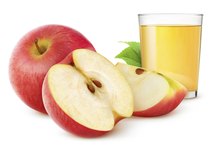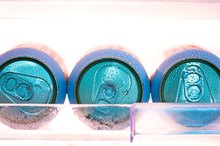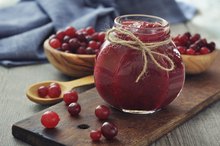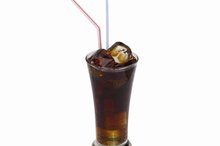Citric Acid in Soda
Ancient and medieval cultures used acid from citrus fruits for hundreds of years before truly understanding its power 2. According to Richard Myers' 2007 book "The 100 Most Important Chemical Compounds," Jabir Ibn Hayyan identified citric acid in eighth century A.D. as the specific chemical responsible for the acidic effect 1. It was Carl Scheele, a Swedish chemist credited with the discovery of oxygen, chlorine and fluorine, who first isolated citric acid in a lab in 1784. This acid is a component of many household cleaners, medications and foods, including soft drinks.
If you are experiencing serious medical symptoms, seek emergency treatment immediately.
Origin
Myers writes that Scheele isolated citric acid by crystallizing lemon juice. It was manufactured in Europe during the early 20th century for industrial and food purposes, but frequent wars in Europe and the subsequent export delays led to American companies developing their own methods of production.
Production
Sorbic Acid in Foods
Learn More
Citric acid was originally produced by adding calcium oxide to citrus fruit juice. Carl Wehmer first developed the process of fermenting sugar to produce citric acid in 1893, but it was not until 1917 that U.S. government scientist James Currie would publish an article on harnessing that power for large amounts of citric acid production.
Function
Citric acid is used in sodas to add tartness 2. While cane sugar or high fructose corn syrup provides the main sweetness source, citric acid provides the sharp, tangy taste found in fruit sodas and colas, according to Understanding Food Additives 2. Different sodas contain different acids to enhance flavor and freshness. Citric acid, malic acid in berry sodas and phosphoric acids in colas not only provide the signature flavor, but lengthen the shelf life of a beverage. John Mallet's Pop Art website, a chemistry magazine formerly published by the University of Nebraska-Lincoln, writes that acid prevents food spoilage.
- Citric acid is used in sodas to add tartness 2.
- Citric acid, malic acid in berry sodas and phosphoric acids in colas not only provide the signature flavor, but lengthen the shelf life of a beverage.
Uses
Acid in Lemon Juice
Learn More
Vicky Clarke maintains a website for people with citric acid intolerance 34. She reports that citrus, tropical and stone fruits, as well as berries, are all natural sources, as are tomatoes, lettuce and cayenne peppers. Food processors add it to sodas, as well as bouillon cubes, canned fruit and tomatoes, jams and preserves and mayonnaise.
Warning
Clarke suffers from a rare intolerance to citric acid 34. She writes that little information exists about the disease due to its rareness, but symptoms mimic other acid intolerance -- gas pain and bloat, stomach cramps and diarrhea. A 2007 report published in the journal "General Dentistry" links acids, such as citric acid, in sodas to enamel wear and decay. An article on the report at LiveScience states that "Non-colas are less acidic than colas overall…but they erode the teeth more effectively than colas."
- Clarke suffers from a rare intolerance to citric acid 3.
- A 2007 report published in the journal "General Dentistry" links acids, such as citric acid, in sodas to enamel wear and decay.
Related Articles
References
- "The 100 Most Important Chemical Compounds"; Richard Myers; 2007
- Understanding Food Additives: Citric Acid
- Vicky Clarke's Citric Acid Intolerance Site: Foods
- Vicky Clarke's Citric Acid Intolerance Site: Intolerance vs. Allergy
- LiveScience: Acids in Popular Sodas Erode Tooth Enamel
- Center for Science in the Public Interest. "Chemical Cuisine — Learn about Food Additives." https://cspinet.org/eating-healthy/chemical-cuisine.
- Codex Alimentarius, Food Additives Online Database. "Codex General Standard for Food Additives (GSFA) Online Database." http://www.fao.org/fao-who-codexalimentarius/standards/gsfa/en/.
- Max B, Salgado JM, Rodríguez N, Cortés S, Converti A, Domínguez JM. "Biotechnological Production of Citric Acid." Braz J Microbiol. 2010 Oct;41(4):862-75. http://www.ncbi.nlm.nih.gov/pmc/articles/PMC3769771/.
- United States Food and Drug Administration Database of Select Committee on GRAS Substances (SCOGS) Reviews"Citric acid." http://www.accessdata.fda.gov/scripts/fcn/fcnDetailNavigation.cfm?rpt=scogsListing&id=82.
- University of Wisconsin Hospitals Health Information: Health Facts for You. "Kidney Health: Citric Acid and Kidney Stones." http://www.uwhealth.org/healthfacts/nutrition/353.html.
Writer Bio
Jared Paventi is the communications director for a disease-related nonprofit in the Northeast. He holds a master's degree from Syracuse University's S.I. Newhouse School of Public Communication and a bachelor's degree from St. Bonaventure University. He also writes a food appreciation blog: Al Dente.









